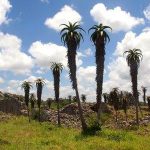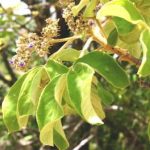TREE LIFE
November 1997
MASHONALAND CALENDER
Tuesday 4th November. Botanic Garden Walk. This month we will continue our study of the figs – from Zimbabwe and elsewhere. A list will be available. We will meet Tom in the car park at 4.45 for 5.00 p.m. and there will be a guard for the cars.
Sunday 16th November. As hoped, we will visit the Bird Sanctuary in the McIlwaine Recreational Park. Understandably the bush is unspoilt here, affording us an excellent opportunity to revise many of the highveld species.
Saturday 22nd November. For venue and time for Mark Hyde’s Walk, please phone him at home
Tuesday 2nd December. Botanic Garden Walk
MATABELELAND CALENDER
Friday 31st October to Sunday 2nd November. Weekend trip to Gwaai Valley Safaris overlooking the Gwaai River Valley
Sunday 7th December. Half-day visit to Mazwi Nature Reserve. Meet at Girls’ college 8-8.30.
NAME CHANGES
Included with this issue of Tree Life are two pages of name changes. You will find them on the last page, which can be detached for easy reference with your tree book. We all know that the taxonomists will continue updating the scientific records, and another list will be compiled when the information becomes known to us. Additional copies of this list and that which was printed several years ago are available on request from the Society.
Christon Bank: 21 September 1997
The Botanic Reserve situated at the end of the Christon Bank road is a fantastic spot and despite its close proximity to Harare, the difference in altitude and the shallow but broken hills make this a really fascinating area. This range of hills, which marks the southern end of Mazowe dam, is composed mainly of really impressive granite formations with occasional doleritic intrusions. After a week of unseasonal rain the hills looked wonderful having been washed clean of dust and now bright with new foliage, a shame that the glorious colours of the Msasas having passed by unnoticed during the wet spell.
A couple of exotics to start the day, with an attractive white flowered Bauhinia on the roadside as well as the more commonly seen species with purple and white petals where the path cuts to the left of the reserve and heads towards a shallow ridge after crossing a shallow but muddy stream thickly clustered with reeds. Here came the first blunder… a rather unwell and leafless Combretum. As nobody was listening to my diatribe a quick stab at the variable Combretum Combretum collinum as a few scattered fruits of large size and pale brown colour lay around, provided an answer or so I thought.
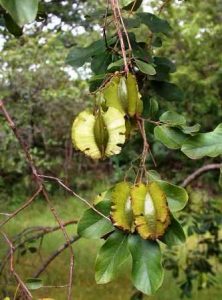
Combretum zeyheri. Photo: Rob Burrett. Source: Flora of Zimbabwe
Vida noticed the gaff as they were in fact a little too big and could be Combretum zeyheri and this is what the ‘books’ say on the matter; “Combretum collinum has scale covered fruits that are longer than broad, the length being about 5cm, whereas Combretum zeyheri has more rounded fruit up to a massive 15cm in size”.
As the elevation of the path rises the soils become more friable being composed of decomposed granite and support both Uapaca species, Uapaca nitida with a delicate leaf supported on slender petioles and the spade size coarse textured leaf of the well known Mahobohobo, Uapaca kirkiana. Stunted Monotes engleri occur sporadically and are noticeable with the white-grey leaf underside yet the supposedly highly visible gland at the leaf base is frequently a shrivelled dot. As the path approaches the granite ridge the vegetation changes with Syzygium guineense favouring the deeper pockets of soil, while termite mounds frequently attract a variety of species due to easy access to ground water and trace elements and here a grove of Zanha africana occurs, when disturbed the dark bark shows a pale red underbark. Nearby, hopeful of a future in gold, a small workers pit was dug some years ago; the thin quartz reef must have been the lure. However, for now the grass grips the eroding sides in an attempt to colonise the disturbed ground along with a solitary Terminalia stenostachya, no mistaking this one for the diagnostic craters found on the previous year’s growth are easily noticed. Colonising the granite ridge above is a large population of Aloe excelsa, one exceptionally tall specimen supported by overhanging branches drew some excited comment – or was it a breathless gasp – from the aloe fundis. Towering over all are the Brachystegia glaucescens and their hybrid kin, their new foliage appearing as a subtle brick red canopy following the boulder-strewn ridge. On a lower level me pale roots of the rock splitting fig Ficus glumosa snake their way into every crack –nature’s a slow but sure demolition machine.
Some surprising finds up here – Mark’s find of Boscia angustifolia deserving some comment; this is a plant normally found in areas of lower altitude and often in arid areas. So what you may ask is it doing here? A possible answer may be that the hills are likely to intercept incoming winds or that they were introduced as below the ridge a large flat area of grassland occurs with the remaining fragments of a human settlement and most of the Boscia family have uses in traditional medicine. The other unusual plant that occurs here in several colonies is an unusual Xerophyta sp. Compared to better known blue flowering Xerophyta villosa, this one has a small and delicate flower with green bracts with tiny yellow petals, the whole plant too is much more slender than its better known relative. A substantial specimen of Pericopsis with its characteristic pale trunk reminded us of the renowned observation of Gill Masterson – dead branches on the left hand side!
The group split up prior to our enthused huddle over the Xerophyta, so our much reduced party continued back to the cars for an early lunch only to be entertained later with stories of magnificent scenery and vista’s overlooking the Mazowe Dam from those whose found the split rock.
Within the reserve an area between the path and stream provides a wide range of species, which may be due to the variation in habitats ranging from riverine, to shallow kopjies composed mainly of granite boulders and small pockets of grassland. A common resident of these boulders is the Rock Agama lizard, with an iridescent blue body and a cocky orange head. A highly territorial creature, which provides hours of entertainment as they chase almost any small pebble flicked in their direction.
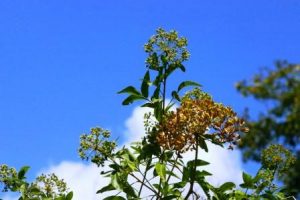
Heteromorpha arborescens. Photo: Bart Wursten. Source: Flora of Zimbabwe
Heteromorpha arborescens and Rhus quartiniana occur close to Commiphora, Commiphora mollis with a grey and slightly fluted trunk, Commiphora marlothii typically green and peeling and the spiny tipped Commiphora africana. For some added variety near the stream, which is dominated by Mimusops zeyheri, a cluster of abnormally large leaves finally revealed a Vitex payos looking rather like one of the cheap imported hand fans from the Far East. The morning’s walk long by Tree Soc. standards must have tired members and for the few energetic souls that made the afternoon walk within the reserve, it was well worth it.
A wonderful place with something for everybody we really must visit it again soon.
-Andy MacNaughtan
TIPS FOR DRIPS – LEAF DESIGN HOW DRIPPY PLANTS PREVENT SOIL EROSION IN RAINFORESTS
The specially shaped leaves of plants growing in rainforests may help conserve the forest soil from erosion. The tips of the leaves often taper into long, elegant spokes pointing downwards, and many botanists believe these so-called drip-tips help to drain off rainwater from the leaves, rather like the tips of an umbrella’s spokes. But Celeste Rebelo from the University of Sao Paulo and G Bruce Williamson at Louisiana State University, Baton Rouge USA, think that drip-tips may be more important in reducing the size of rainwater drops falling off the leaves and splashing more gently onto the ground underneath, thereby saving the soil from erosion (Biotropica, vol. 28, pp. 159-63).
They measured leaf drip-tips on plants growing in three neighbouring locations in the heart of the Amazon. The drip-tips of plants growing on clay soils were largest, whereas plants growing on sandy soils had much smaller drip-tips. As all the plants grew in the same climate, it is most likely that soil holds the key difference.
Erosion may lie at the heart of the drip-tip differences. Clay soils are so poorly drained that the ground becomes easily saturated, and the rain can wash off surface particles in a miniature flood, whereas sandy soils can soak up more water and accommodate heavy rainfall. So, by shedding rainwater in a softly-softly approach, drip-tips are easing the drainage problems of clay soils. But this erosion theory of drip-tips may only apply to the Amazon region, because scientists in other parts of the tropics have found that climate is the vital factor with the longest drip-tips occurring in the wettest regions.
-Paul Simons.
BACKGROUND
Leaf cuttings
If leaves of rainforest plants don’t get rid of rainwater quickly, it can build up a film that reflects sunlight, blocks the leaf pores, leaches out nutrients and encourages the growth of parasite infections and epiphytic plants. It’s thought that the leaf drip-tips are one way of draining that water off, helped by the leaf veins, which siphon off water rather like the treads of car tyres.
This interesting article is acknowledged with thanks to author and BBC Wildlife Oct.1996.
BOTANIC GARDEN WALK: 7 OCTOBER 1997
The subject was figs. Maureen had prepared a very useful list of the 24 species of fig to be found in Zimbabwe and this was available at the meeting.
First, a brief summary of the general features. Figs belong to the genus Ficus in the family Moraceae. They often begin life as an epiphyte later sometimes becoming terrestrial or are terrestrial from the start. The leaves are simple and alternate and a scar is left where the apical bract breaks away. Another important feature is the milky latex is produced from the stems when they are broken. There are glandular, often waxy spots, on the underside of the leaves. The flowering and fruiting takes place within a nearly closed receptacle, the fig itself. Pollination depends on various species of wasp.
The woody habit, alternate leaves and milky latex mean that figs cannot usually be confused with anything else, but one possibility is the Sapotaceae and in particular, Mimusops zeyheri. However, as Tom pointed out, that species lacks the apical bracts and the stem scar. Another possible confusion is with Trilepisium madagascariense, in the same family, but this lacks the glandular spots and also the flower is open and does not take place within an enclosed “fig”.
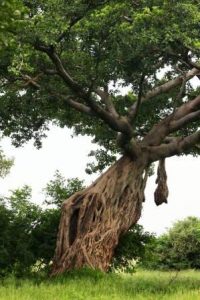
Ficus bussei. Photo: Bart Wursten. Source: Flora of Zimbabwe
We first looked at Ficus bussei (formerly Ficus zambesiaca). In Zimbabwe, this is confined to the Northern Division and in particular the Zambezi River, where it occurs at low-altitudes often in riverine habitats and often on alluvial soils. It is a large and handsome tree, often broader than tall. It occurs at Mana Pools where it is such a major feature. The leaves are quite hairy and have a cordate base.
On to Ficus sycomorus, a very widespread species extending from S. Africa to Israel. This is a well-known species of low-altitude riverine habitats, with rough leaves (although not as rough as a real sandpaper fig) and a distinctive greenish-yellowish bark. It also occurs in woodland and on termite mounds, even at quite high altitudes. The leaves are somewhat like Ficus sur (but that species has leaves which are not so rough) and both species have their fruits borne, on special short woody branches on the main branches and trunk.
From a fairly common species to an extremely rare one; Ficus vallis-choudae is extremely rare in Zimbabwe, occurring only in the Haroni-Rusitu area, where Tom reckons there are probably no more than 50 trees. Its habitat is riverine forest and it has proper buttresses like many true forest species. The figs are relatively large. Another species confined to the Eastern Districts is Ficus chirindensis. This is a common tree in the Chirinda Forest, but occurs quite widely in other E. Districts forests. For example, Tom mentioned that it occurs at the Vumba, but not at the highest levels, probably up to c.1400 m. In the Chirinda Forest, this species surrounds and kills its host, having an extraordinary cylindrical freestanding lattice structure of Ficus stems. The fruits are medium sized and occur abundantly on short branches off the old wood. The apical bract is particularly long.
Another E. Districts species is Ficus scassellatii, which was seen by the Society on its recent visit to the Vumba. The leaves are leathery, laurel-like and very dark green. The apical bract is short.
Ficus craterostoma, the Rare Forest Fig, is obviously similar to Ficus natalensis, with glossy smooth leaves and a truncate to emarginate leaf tip. Tom also showed us a variety of Ficus thonningii that occurs in E. Districts forests this was not at all like our savannah Ficus thonningii and illustrates the difficulty of this thonningii/natalensis/craterostoma group.
Finally, Ficus stuhlmannii, a rather rare low-altitude species was examined.
-Mark Hyde Next week – part 2 of the figs.
THE TREES OF EILAND LIVING FOSSILS AND DINOSAURS
No, that is not meant to be Ireland – there is an EILAND (pronounced alant) an oasis tucked away in the eastern corner of the Northern Transvaal, near Tzaneen, the gateway to the Eastern Transvaal. Situated in the Hans Merensky Nature Reserve and surrounded by lush bush, a cool mineral spring gushes forth to fill tiled pools; a hydro over the spring itself, another artificially heated to a warm inviting temperature and the other cool and challenging.
Eiland is deceptive – at first only the orange, yellow and gold of the Colophospermum mopane are to be seen, but on entering the resort between the neat rows of thatched rondavels and green lawns, trees of every kind appear, many labelled. Here you can test your knowledge, identify the trees first and then read the label. All in leaf so identification is made easy. The tree list gives 104 including 7 Acacia, 7 Combretum, 4 Commiphora, 8 Grewia and 3 figs. Those not in the resort are to be found in the nature reserve where walking trails have been laid out and the game scouts will accompany you down to the riverine bush on the Great Letaba River, where I am told the trees grow to a great size.
At the end of winter only the Acacia nigrescens and Acacia xanthophloea are in flower but other trees are putting out blossoms and the sweet scent of Euclea divinorum hangs in the air. Leftovers (particularly mealie meal) from last night’s braai are shared by buck, hornbills and birds of many kinds and a family of warthog and guineafowl wander as they please. Channels of spring water run through the resort and in the evening frogs come into their own with a deafening cacophony of sound. Each low season and when the temperatures drop on the Rand many retired couples spend the cold months here in their luxury caravans enjoying the warmth. It is no hardship – there are all facilities, a well-stocked shop that sells anything from snazzy swimsuits to the daily milk and bread, and butchery and a bottle store.
In the nature reserve itself – you can walk and you can drive, the roads are good – it is always the luck of the draw as to what game will be seen but trees, predominantly Colophospermum mopane and Sclerocarya birrea (mopane and Marula) there certainly are. Eiland is an ECO resort and thus the resident game ranger will take you out on a game drive either in the morning or the evening – the evening is preferable because he will grill your supper under the starlight sky and never has boerewors tasted so good.
Cycads are not trees but by sheer size I think the most famous and largest of the Cycads Encephalartos transvenosus could be called a tree, usually reaching a height of about 5-8m but sometimes even exceeding the 13m mark. With their bare trunks topped with 2m long lush, deep green leaves, these Cycads are often mistaken for palms. In “Secret Southern Africa” we read –
“Experts call them ‘living fossils’; they date back to the age of the dinosaurs, the Mesozoic Age some 50 or 60 million years ago, when they were particularly prolific all over the earth and probably formed a substantial part of the dinosaurian diet.”
Here they can be seen in the Kingdom of the Rain Queen (the Modjadji) where there is a unique 305 ha forest stringently protected by generations of Rain Queens and hence the common name of ‘Modjadji Cycad.’ There is also a colony in the misty Wolkberg Wilderness area near Pietersburg. Modjadji is not far from Duiwelskloof, which you pass through on the way from the North and here too hiking traits lead through this unique forest. Unfortunately heavy mist precluded us from visiting but we did find a ‘baby’ at a nursery in Duiwelskloof which I was tempted to buy (a permit would be no problem) but even at that tender age its leaves were at least three-quarters of a metre long and space did not permit. The cone, too, is half a metre tall.
Eiland being so close to Tzaneen leads to temptation to visit the scenic wonders of the Eastern Transvaal, all unusual and interesting.
The view site at God’s Window is rather special – God’s Window is higher that Table Mountain and you can walk through a rainforest where so many of the trees and plants are similar to those on Table Mountain.
Another special was much further down and were ancient dolomite caves and a dinosaur park. The Sudwala Caves are older than the Cango Caves and here can be found a circular chamber (67m in diameter and a dome of 37m high) known as ‘The Crystal Chamber’ famous for its acoustics; on the day we visited, the Drakensberg Boys Choir were to give an evening recital. Here, too, are the dinosaurs in their lush garden of large Alsophila dregei (tree ferns) smaller Cycads and trees of every description, the Dombeya rotundifolia being in full flower. Like the cycads they are creatures of a Mesozoic Age, very realistic and rather frightening. It would be as well to take heed of the warning, which reads, “Trespassers will be swallowed”.
-VdeVS.
SNIPPET.
Some time back an extract from the publication “Beyond Supernature”, by Lyall Watson, appeared in Tree Life. This extract gave an account of how southern African bushveld trees respond rapidly to heavy browsing pressure by producing extra tannins in their foliage as a defence mechanism. The tannins not only make the browse temporarily unpalatable, but also can even make it lethal. A bizarre twist to this research finding was the discovery that untouched trees close by also increases their tannin content within a very short time, apparently in sympathy with their damaged
An even more bizarre discovery was reported in the National Geographic magazine of December 1989. Scientists have found that some plants emit ultrasonic acoustic emissions (ultrasonic chirps) when they are affected by drought stress, and the chirps increase as stress intensifies. Further experimental probing showed that bark beetles evidently recognize the distress signals and home in on the affected plants, while tending to leave “chirping” plants alone.
-Lyn Mullin.
NAME CHANGES
OLD NAME NEW NAME
Acacia albida Delile Faidherbia albida (Delile) A. Chev.
Bequaertiodendron magalismontanum Englerophytum magalismontanum
(Sond.) Heine & J.H. Hemsl. (Sond.) T.D. Penn.
Bequaertiodendron natalense Englerophytum natalense
(Sond.) Heine & J.H. Hemsl. (Sond.) T.D. Penn.
Byrsocarpus orientalis (Baill.) Baker Rourea orientalis Baill.
Canthium burtii sensu Palgrave Canthium pseudorandii Bridson
Canthium frangula S. Moore Canthium glaucum Hiern ssp. frangula
(S. Moore) Bridson
Canthium pauciflorum (Klotzsch) Kuntze Canthium kuntzeanum Bridson
Canthium pseudoverticillatum S. Moore Canthium ngonii Bridson
Cassine aethiopica Thunb. Mystroxylon aethiopicum (Thunb.) Loes.
Cassine matabelica (Loes.) Steedman Elaeodendron matabelicum Loes.
Cassine papillosa (Hochst.) Kuntze Elaeodendron capense Eckl. & Zeyh.
Cassine schlechteriana Loes. Elaeodendron schlechterianum (Loes.) Loes.
Cassine transvaalensis (Burtt Davy) Crocoxylon transvaalense
Bredell (Burtt Davy) N. Robson
Coffea sp. J Coffea zanguebariae Lour.
Commiphora merkeri Engl. Commiphora viminea Burtt Davy
Cordia abyssinica R Br. Cordia africana Lam.
Cordia ovalis A. DC. Cordia monoica Roxb.
Courbonia glauca (Klotzsch) Gilg. & Bened. Maerua decumbens (Brongn.) DeWolf
Croton scheffleri sensu auct. Croton longipedicellatus J. Léonard
Croton sp. no.1 sensu Drummond in Kirkia 10:252 (1975). Croton madandensis S. Moore
Dracaena usambarensis Engl. Dracaena mannii Baker
Faurea saligna ssp. no 1. sensu Drummond (1975) Faurea delevoyi De Wild.
Faurea speciosa (Welw.) Welw. Faurea rochetiana (A. Rich.) Pic. Serm.
Hippocratea africana (Willd.) Loes. Loeseneriella africana (Willd.) N. Hallé
var. richardiana (Cambess.) var. richardiana (Cambess.) N. Hallé
N. Robson
Hippocratea buchananii Loes. Reissantia buchananii (Loes.) N. Hallé
Hippocratea crenata (Klotzsch) K. Schum. Loeseneriella crenata (Klotzsch) N. Hallé
Hippocratea goetzei Loes. Simirestis goetzei (Loes.) R. Wilczek
Hippocratea indica Willd. Reissantia indica (Willd.) N. Hallé
Hippocratea longipetiolata Oliv. Pristimera longipetiolata (Oliv.) N. Hallé
Hippocratea pallens Oliv. Apodostigma pallens (Oliv.) R. Wilczek
Hippocratea parviflora N.E. Br. Reissantia parviflora (N.E.Br.) N. Hallé
Hippocratea parvifolia Oliv. Elachyptera parvifolia (Oliv.) N. Hallé
Hippocratea volkensii Loes. Pristimera andongensis (Oliv.) N. Hallé
Mathew var. volkensii (Loes.) N. Hallé & B.
Khaya nyasica Stapf ex Baker f. Khaya anthotheca (Welw.) C.DC.
Philippia benguellensis (Welw.) Britten Erica benguelensis (Engl.) E.G H. Oliv.
Philippia hexandra S. Moore Erica hexandra (S. Moore) E.G.H. Oliv.
Philippia mannii (Hook. f.) Aim & Fries Erica mannii (Hook. f.) E.G.H. Oliv.
Psoralea foliosa Oliv. Otholobium foliosum (Oliv.) C.H. Stirt.
Rhus dentata sensu Drummond Rhus transvaalensis L.C. Leach
Ricinodendron rautanenii Schinz Schinziophyton rautanenii (Schinz) Radcl.-Sm.
Santaloides afzelii (Planch.) Schellenb. Rourea minor (Gaertn.) Alston
Uapaca sp. no.1 sensu Drummond in Kirkia 10:251(1975). Uapaca lissopyrena Radcl.-Sm.
Vitex amboniensis Gürke Vitex ferruginea Schumach. & Thonn
ssp. amboniensis (Gürke) Verdc.
ANDY MACNAUGHTAN CHAIRMAN


